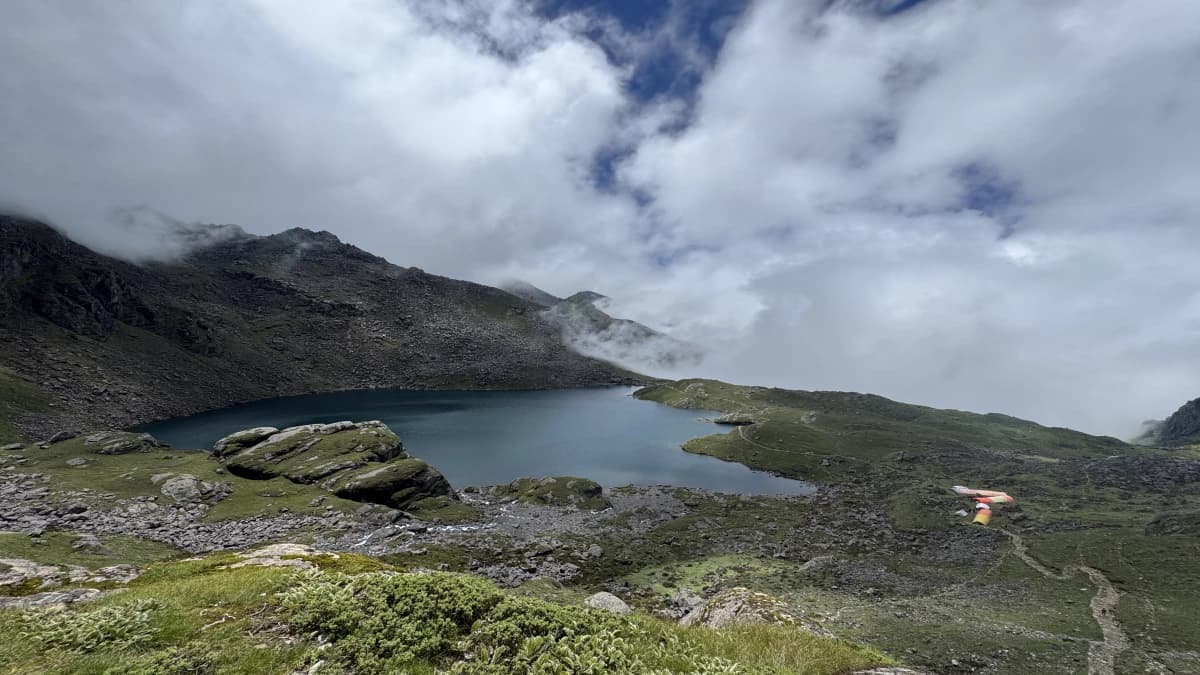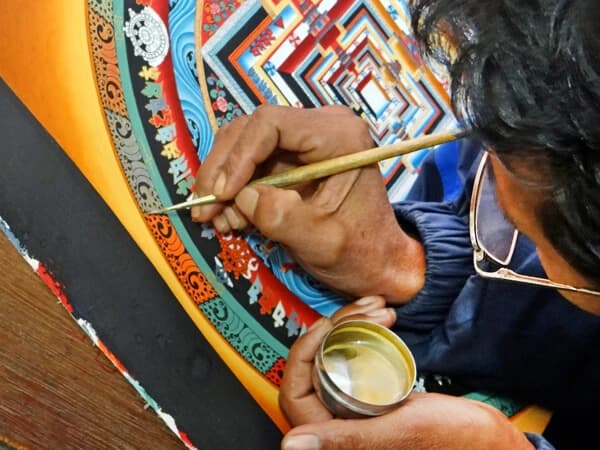Pilgrimage to Gosaikund for Janai Purnima Festival
Part 1 – From Kathmandu to Chandanbari
There was this quiet sense of anticipation, because we weren’t just traveling anywhere—we were heading to the famous Janai Purnima festival, a special occasion that draws tens of thousands of pilgrims each year – but later more on that… This year me, Titou and my Nepali host parents were part of it.
Our adventure began on a glowing morning in the heart of Kathmandu at 6 am. Leaving from a lively local market where the city was already in full motion. People were busy with their daily routines, stalls piled high with fruits and goods, and we even managed some last-minute shopping—grabbing fresh apples and bananas for the road. Thanks to our excellent guide, finding the there right ride: a sleek EV bus, driven by a truly skilled driver who knew the roads like the back of his hand was effortless.
So off we went in the supper acceleration EV 9 Seater, filled with11 people. Because it was an electric vehicle, we had to pause midway to recharge. The stop was perfect—a 40-minute window to stretch, enjoy some breakfast tea, and have some relaxed conversations with other Nepalese travelers in our car. The Van trip alone was worth a movie, full of beautiful sceneries, Waterfalls and interesting faces and outfits.
Finally after 5 or 6 hours we reached Dhunche from where we would start our hike, but before that we had lunch at a sweet little place perched on a balcony overlooking the valley and surrounding mountains—a view that made our midday break feel like a small reward before the trek, filling our bellies. After lunch, we began our ascent. A staggering 1,300 meters of ascent we would cover that first day. The first stretch before the ascent was about an hour of steady walking, then quickly turning into a really steep climb. The landscape along the way was nothing short of spectacular: rivers, waterfalls, hanging bridges, varied flora, and ultimately the chance to witness the terrain evolve with every step. The trail was well-equipped for pilgrims: spots to refill water, grab a snack, and take a short rest appeared regularly, ensuring that even though the climb was physically demanding, it remained comfortable.
Because it was festival season, the trail was alive with people of all ages and backgrounds. Shamans practicing the Bon religion, an older form of Tibetan-Nepali spiritual tradition, carried tambourines and performed shamanic rituals as they ascended, their drumming and chanting infusing the pilgrims with a unique energy. Children, adults, and elderly pilgrims alike made the climb, some in traditional, colorful attire. And then there was this unforgettable sight: an elderly woman walking her yak up the mountainside, as if she were just window-shopping in her neighborhood—utterly impressive – and the animals she was walking gorgeous. We reached our first night shelter in Chandanbari just before heavy rain began to fall—a perfect timing, almost cinematic.
Festival season meant the village was packed, but the locals were amazing in accommodating everyone. Our sleeping arrangements were simple—an attic shared with other travelers—but it was dry, warm, and came with plenty of blankets, food, and hot water. The family running the guesthouse went out of their way to make the experience welcoming, offering seconds and thirds of soooo delicious food and even hot morning showers – even though I preferred having a cold one in the evening. There was something special about sleeping in a big communal space during such a vibrant pilgrimage—it made you feel connected to everyone on the journey.
By nightfall most were crawling into bed as we got ready for the second day of our trek. I knew we would get up early I felt excited about what lay ahead, knowing that the mountains and the festival would continue to reveal their wonders.
Part 2 The Ascent and Sacred Purification
Before continuing with our trek, it’s worth understanding the spiritual significance of this pilgrimage. According to mythology, during the Samudra Manthan, or the churning of the ocean, a deadly poison called Halahala emerged, threatening to destroy the world. To save all beings, Shiva drank the poison, holding it in his throat to prevent it from spreading through his body. His throat turned blue, earning him the name Neelkanth, “the Blue-Throated One.” Parvati, his consort, stood by him, supporting him and protecting the world from the poison’s wrath. It is said that Gosaikunda, the sacred lake we were heading to, was created when Shiva struck the ground with his trident to cool the earth after consuming the poison. Pilgrims come here to purify themselves in its icy waters, following in the footsteps of countless generations who have sought spiritual cleansing and renewal.
The next day, we woke before dawn, the air already crisp with altitude. Gosaikunda lies at 4,300 meters, and we were starting from 3,300—meaning a thousand meters of climbing still awaited us. The first stop was Lauribina. My host parents, feeling the strain of the thin air and mild headaches, decided to continue on horseback. For them, it was a joyful way to conserve energy, and for me, it meant I could really enjoy my thighs power, savoring each step of the climb, as I kept up with the horses.
From Lauribina, the trail opened up to breath-taking views. The clouds began to lift, sunlight spilling over the surrounding mountains, and the landscape revealed waterfall after waterfall, streams tumbling into crystal-clear pools, and magnificent high-altitude lakes sparkling in the sun. New view, each more spectacular than the last, kept coming our way. Along the way, the rhythm of pilgrims’ chants and the sight of colorful attire, prayer flags, and joyful faces created a sense of celebration and shared purpose.
As we approached the Buddha Mandir, a small temple adorned with vivid colors and a statue of Padmasambhava preceding it, there was a natural pause in the climb. The temple offered a moment for quiet reflection—a chance to breathe, to meditate, and to feel the sacred energy of the mountains and the pilgrims around us. The closer we got to Gosaikunda, the more the atmosphere shifted; the anticipation was palpable, and the festival energy grew, echoing off the rocky slopes.
The final ascent to the lake was intense but exhilarating. And then, finally, Gosaikunda appeared—sunlight glinting off its clear surface, the surrounding rocky hills framing it like a natural cathedral. Pilgrims celebrated their arrival, ready to immerse themselves in the waters, carrying the hope of purification and renewal. We, too, left our gear at the guesthouse and descended to the lake, feeling the sharp, invigorating chill of the water and the profound sense of accomplishment that came with completing our pilgrimage.
That evening, after a simple but warm meal with other pilgrims, we reflected on the day’s journey. The monsoon had caused some minor problems—water leaking from the roof—but the community spirit and hospitality quickly resolved everything. Sitting together, sharing stories, laughter, and food, it became clear that this pilgrimage was as much about connection and human experience as it was about spiritual purification.
The next day, the descent awaited: 3,000 meters of altitude loss, 2,300 on foot and 700 more in the EV. Every step offered a new perspective on the mountains we had conquered, the lakes we had passed, and the incredible effort it took to reach the sacred lake – memories were flowing. At Chandanbari, where we slept on our way up, we stoped for lunch as the host family was so kind and food soooo delicious. we paused to enjoy some local cheese—rich and flavorful — one you could just as well find in the Swiss alps; a simple yet memorable reward after days of trekking.
By the time we reached the EV, exhaustion mingled with satisfaction, and the ride back to Kathmandu allowed everyone to rest and reflect on an unforgettable journey.
This pilgrimage is more than a trek; it is a journey through breathtaking landscapes, vibrant human culture, and timeless spiritual tradition. The experience is intense, empowering, and deeply rewarding—a true celebration of the mountains, the festival, and the enduring devotion of those who make this climb. For anyone seeking purification, adventure, or simply to witness Nepal at its most majestic, Gosaikunda is an absolute must.
Ten out of ten, absolutely worth it. Hope to see you there next time <3




